Pest and Pesticide Monitoring
Locust swarms can include tens of millions of insects. Wherever they land, crop or pasture loss can be 100 percent within hours. Photo credit: Yene Belayneh, USAID/BHA
Transboundary outbreak pests (ETOPs), including locusts, grasshoppers, armyworm and rodents, mean disaster for millions of people whose livelihoods depend on farming in several dozen countries around the world. The damage is more so in sub-Saharan Africa, Asia and Latin America. The desert locust alone threatens livelihoods of millions of people in more than 65 countries throughout Africa, the Middle East, and Southwest Asia. With the right ecological conditions, these insect pests can form dense swarms that quickly devour crops and pasture land, leaving people and animals without food to eat and pasture to graze. Farmers can see a year's worth of work and sometimes sole means of supporting their families destroyed in moments.
Just as the weather can be forecast, USAID contends that favorable conditions for the proliferation of ETOPs can be predicted in advance. By working together with many international, national, regional and local organizations and partners, USAID is investing in monitoring, early warning, and early action to control locusts and other ETOPs and prevent them from causing massive damage to the livelihoods of vulnerable communities.
USAID created the Assistance for Emergency Locust/Grasshopper Abatement (AELGA) project in the late 1980s to deal with the plague of locusts and grasshoppers that affected much of Africa, the Middle East, and Southwest Asia over many years, and assist affected countries to prevent future major invasions. Formerly known as the Africa Emergency Locust/Grasshopper Assistance project, AELGA's overall objective is to help establish and strengthen national and regional capacities to prevent and control locusts, grasshoppers, and other ETOPs. ALEGA also strives to minimize and eliminate the adverse effects of pesticides to humans, their assets, to non-target and beneficial organisms as well as the environment.
Emergency Transboundary Outbreak Pests (ETOP)
FY 2024
ETOP update, March 2024 (522kb PDF)
ETOP update, February 2024 (557kb PDF)
ETOP update, January 2024 (491kb PDF)
ETOP update, December 2023 (558kb PDF)
ETOP update, November 2023 (1020kb PDF)
ETOP update, October 2023 (716kb PDF)
FY 2023
ETOP update, September 2023 (647kb PDF)
ETOP update, August 2023 (1.4mb PDF)
ETOP update, July 2023 (668kb PDF)
ETOP update, June 2023 (830kb PDF)
ETOP update, May 2023 (634kb PDF)
ETOP update, April 2023 (557kb PDF)
ETOP update, March 2023 (398kb PDF)
ETOP update, February 2023 (420kb PDF)
ETOP update, January 2023 (461kb PDF)
ETOP update, December 2022 (533kb PDF)
ETOP update, November 2022 (528kb PDF)
ETOP update, October 2022 (579kb PDF)
FY 2022
ETOP update, September 2022 (490kb PDF)
ETOP update, August 2022 (523kb PDF)
ETOP update, July 2022 (1mb PDF)
ETOP update, June 2022 (562kb PDF)
ETOP update, May 2022 (828kb PDF)
ETOP update, April 2022 (815kb PDF)
ETOP update, March 2022 (606kb PDF)
ETOP update, February 2022 (429kb PDF)
ETOP update, January 2022 (548kb PDF)
ETOP update, December 2021 (596kb PDF)
ETOP update, November 2021 (599kb PDF)
ETOP update, October 2021 (790kb PDF)
FY 2021
ETOP update, September 2021 (978kb PDF)
ETOP update, August 2021 (703kb PDF)
ETOP update, July 2021 (851kb PDF)
ETOP update, June 2021 (1007kb PDF)
ETOP update, May 2021 (932kb PDF)
ETOP update, April 2021 (795kb PDF)
ETOP update, March 2021 (691kb PDF)
ETOP update, February 2021 (663kb PDF)
ETOP update, January 2021 (615kb PDF)
ETOP update, December 2020 (652kb PDF)
ETOP update, November 2020 (499kb PDF)
ETOP update, October 2020 (574kb PDF)


